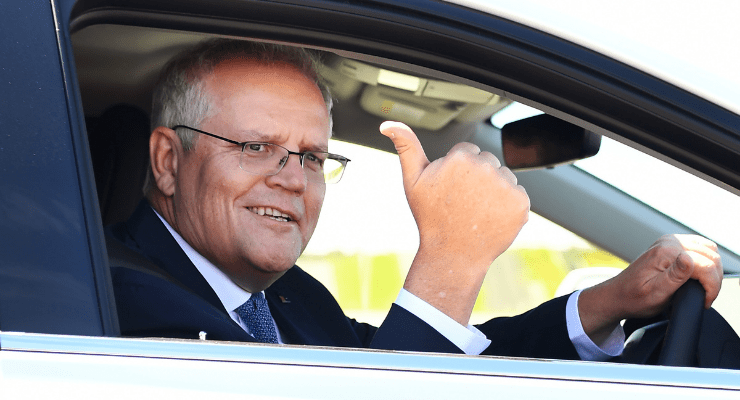
If you were wondering whether Australia’s media has learnt anything from the last election, these past few days have given us the answer: no. No, they have not.
Take Sunday night’s television news: Albanese following up Friday’s long-awaited climate change policy with an education offering, wrapped in a soft campaign launch for “A better future”; Morrison fanboying racing cars in Bathurst, stumbling over his “windscreen not rear-view mirror” talking point for the day.
Wondering which got the best coverage? Don’t. If you’ve been paying attention, you already know — it was Morrison visuals all the way down, the 2019 election action man redux, subtweeting electrical vehicles with the roar of internal combustion on the way through.
Or take the media’s eagerness over the weekend to jump on board with the anonymous sources leaking the “Berejiklian for Warringah” stunt, trampling over concerns about the Coalition’s women’s issues which just last Friday threatened to become this summer’s no-hose-holding moment.
It’s not the fault of individual journalists in Australia’s political press corps. They churned out plenty of strong reporting and analysis of Labor’s climate plans. The Morrison government’s entire “women’s problem” came out of the deep digging by individual reporters over the past 18 months.
And as Morrison himself apparently admitted to new Nine CEO MIke Sneesby, the company’s analysts and commentators are hurting him — and he’s “grumpy, not furious” about it. He shouldn’t worry. Most of this commentary is safely hidden behind paywalls, well away from his target audience.
No, it’s not so much the reporters. It’s the business model.
We’ve long understood that, when it comes to politics, the financial imperative of drawing audiences means news media have to be as entertaining as they are useful, as the late Anthony Downs (he died just two months ago) wrote in his still-essential 1956 text, An Economic Theory of Democracy.
Trouble is, in the age of viral memes and clickbait, business survival has driven the ad-supported mass media (the media that most voters see) to prioritise the giggling entertaining moment over the responsibility to give voters (that’s us!) the useful information they need. It substitutes a patchwork of populist imagery, punchy media grabs and gotcha questioning for the contest of policy-driven ideas that is the (theoretical, at least) purpose of news media in a democratic society.
Let’s be honest: a deliberately dorky middle-aged man hanging on for dear life as a speeding car rollercoasters around Bathurst’s Panorama circuit is far more visually entertaining — funny, even — than, say, Albanese’s sober presentation of policy (his schmick new glasses notwithstanding!). But unless you’re prepared to decode the semiotics of it all, its utility to voters is approximately — um, add one, carry the two — nil.
Traditional journalistic practice struggles. “Both sides-ism” is hammered in so deep that Australia’s media are just not equipped to report this sort of asymmetric politics.
The Washington Post last week brought data analytics to the job in a “sentiment analysis” of more than 200,000 reports from 65 news websites to compare the media’s treatment of Biden and Trump when each was president. Shockingly, they found that Trump was both more reported and reported more favourably than Biden.
The right wing media (like the Murdochs’ New York Post) were predictably negative. But so, too, were the non-aligned media like Politico and even progressive voices like HuffPost and Salon.
Analysing the outcome, senior columnist Dana Milbank pointed to asymmetry: “Biden governs under traditional norms, while Republicans run a shocking campaign to delegitimise him with one fabricated charge after another.”
Translated to Australia: Albanese (and Shorten in the 2019 campaign before him) have to figure out how to run a traditional (albeit small-target) campaign against the unashamedly “pants on fire” Liberal and National Parties. And the media need to figure out how to report that fairly in the public interest.
Milbank points to two more problematic reactions: “Perhaps journalists, pressured by Trump’s complaints about the press, pulled punches. Perhaps media outlets, after losing the readership and viewership Trump brought, think tough coverage will generate interest.”
Same, again, in Australia. The conservatives work the refs harder than Labor (as Morrison did on Sneesby last week). And they’ve got an added weapon: they know they can rely on News Corp to work over the rest of the news media on their behalf.








Crikey is committed to hosting lively discussions. Help us keep the conversation useful, interesting and welcoming. We aim to publish comments quickly in the interest of promoting robust conversation, but we’re a small team and we deploy filters to protect against legal risk. Occasionally your comment may be held up while we review, but we’re working as fast as we can to keep the conversation rolling.
The Crikey comment section is members-only content. Please subscribe to leave a comment.
The Crikey comment section is members-only content. Please login to leave a comment.